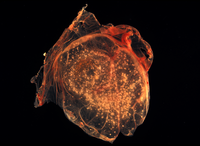
Photo from wikipedia
Rapid endometrial adaptations occur with the embryo entering the uterus to create a receptive uterine environment, which is essential for the conceptus' development. The aim of this study was to… Click to show full abstract
Rapid endometrial adaptations occur with the embryo entering the uterus to create a receptive uterine environment, which is essential for the conceptus' development. The aim of this study was to demonstrate ultrastructural and histological changes of the endometrium at day 5 after ovulation in cyclic and inseminated mares. Mares were daily examined by transrectal palpation and ultrasonographic examination of the reproductive tract until ovulation was detected. In the first cycle, endometrial biopsies from 10 cyclic mares (Cyclic group) were collected on day 5 post-ovulation. In the second cycle, the same mares were inseminated with fresh semen from a fertile stallion (Inseminated group). Intrauterine biopsies were collected on day 5 post-ovulation, and according to sampling moment, inseminated mares were subdivided into two subgroups, those sampled at day 5-5.5 (n = 5) and those sampled at day 5.5-6 (n = 5). Biopsy samples were analyzed through scanning electron microscopy and light microscopy. Inseminated group presented an increase in glandular diameter, decrease in ciliated cell population, and an increase in lymphocyte population, compared to Cyclic group. No differences were observed between both experimental groups in number of micro-ciliated polygonal cells, percentage of flat or protruded cells in the epithelium, amount of secretion over the epithelium, glandular density, glandular luminal diameter, height of the glandular epithelium, amount of intraglandular secretion, blood vessel diameter and number of eosinophils and neutrophils. No differences in any of the variables were detected between subgroups from inseminated mares. These facts lead to the hypothesis that there is some sort of signaling to prepare and adapt the uterus to maintain pregnancy even before embryo arrival. There is also evidence to support an alternative hypothesis suggesting that all of the above mentioned are inflammatory events, resulting from a previous inflammation due to residual seminal effects. The results here presented lead to the conclusion that significant ultrastructural and histological changes of the endometrium occur on day 5 post ovulation in inseminated mares.
Journal Title: Theriogenology
Year Published: 2019
Link to full text (if available)
Share on Social Media: Sign Up to like & get
recommendations!